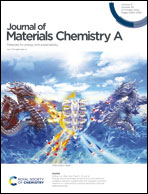Spontaneous energy generation at the air–hydrogel interface with ultrahigh ion activity†
Abstract
Spontaneous and continuous collection of water energy from the natural environment provides an ingenious alternative for green electricity technologies. However, power generation using hygroscopic materials usually decays quickly in a few hours, making it difficult to obtain sustained electricity. Herein, different from previous principles, a novel mechanism-based, that is, air–hydrogel interface induced electric generator (AIEG) is proposed with excellent power output holding time. Significant ion enrichment with ultrahigh activity is first noticed in power generators sourcing from water. The ultrahigh activity leads to high power output with extraordinarily prolonged running time. The AIEG system is capable of running continuously day and night, providing a voltage of 0.2 V for more than 1 month and a current density of 23.75 μA cm−2 over a week without obvious decay. As a demonstration of practical application, eight pieces of AIEG were connected in series to power a clock. The work illustrates that the ionic hydrogel based AIEG holds great promise in self-powered wearable equipment and electronic skins due to its portability and flexibility. Moreover, different from previous studies, the innovative mechanism opens a brand-new perspective to develop weatherproof green energy-harvesting devices.



 Please wait while we load your content...
Please wait while we load your content...